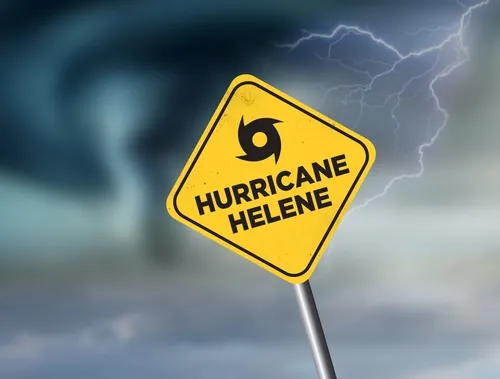Hurricane Helene: Its Impact on the Southeast Region
Just a little over two weeks ago, Hurricane Helene made landfall in Perry, Florida, in the late hours of Sept. 26. The Category 4 storm left an extensive amount of damage in its wake from the west coast of Florida up into the mountains of North Carolina, where it hit the hardest.
The aftermath of Helene left millions without power and homes, causing extreme flooding, landslides, and even loss of life.
Hurricane season can bring times of uncertainty and disruption, even to the supply chain. The supply chain allows for necessities to be delivered efficiently, relying heavily on road and rail transportation.
However, hurricanes bring heavy rain, wind, severe flooding, and, in cases such as Helene, destruction to roadways, making it impossible for trucks to pass through. This can lead to dangerous conditions for drivers, delivery delays, and cargo loss, especially perishable goods.
It’s crucial for businesses to prepare and plan ahead during hurricane season to help mitigate any disruptions that may occur.
How Hurricane Helene Impacted The Supply Chain
Hurricane Helene brought mass destruction to the Southeast, with many communities in North Carolina left with nothing. Due to the loss of infrastructure and power, there have been major disruptions to the supply chains in the region, specifically within the retail, automotive, and agricultural sectors.
These disruptions are being felt already on a national level and will continue within the upcoming months as businesses get back on their feet.
Marion, North Carolina, produces a large majority of IV fluids used by hospitals across the U.S., causing a nationwide shortage that’s already being felt. Spruce Pine, NC, produces a large majority of quartz, which is used in the production of semiconductors and solar panels, and we will likely start to see a shortage in production as well.
Farmers in Georgia experienced devastating crop losses, including cotton, peanut, and pecan crops. One-third of the cotton crop in the state is lost, and more than 220 poultry houses have been destroyed, according to the Augusta Chronicle.
These shortages can have devastating impacts on the supply chain, with many of the products being either high in demand or necessary for medical needs.
Due to the ruined roadways and rail lines in the region, delays in shipping imports and exports are expected until those networks are repaired.
It’s unclear to what extent these shortages and disruptions will impact the supply chain and for how long, but recovery efforts are currently underway for the affected areas.

Recovery Efforts
In Florida, recovery efforts continue after another massive hurricane hit the west coast on Oct. 9.. In North Carolina, where Hurricane Helene brought the most destruction, communities are slowly but surely working towards normality.
While some communities have revived, other harder-hit areas are still without water or power. Search and rescue missions are underway for those who are still unaccounted for.
According to FEMA, federal support for survivors of the hurricane has now surpassed $210 million, while water and other necessities are being brought into the region for those in need.
How to Prepare for Hurricane Season
Although hurricane season can prove to be volatile, it’s crucial for the transportation and logistics industry to be prepared to help reduce any disruptions that the strong storms can bring.
The logistics and transportation industry relies on good weather in order to transport freight safely and efficiently. However, the weather conditions that hurricanes bring can delay this process. There are various ways that businesses can keep updated with weather conditions in order to ensure that the driver and freight are safe. Alert systems that give real-time updates in cases of natural disasters like Hurricane Helene include:
- Wireless Emergency Alerts (WEA)
- NOAA Weather Radio (NWR)
- NOAA Weather Wire Service (NWWS)
- Emergency Alert System (EAS)
- Emergency Managers Weather Information Network (EMWIN)
- Interactive Weather Information Network (IWIN)
- NOOAAPORT
Other steps that businesses can take include continuing to build a strong supply chain through communication with local suppliers and other networks, as well as increasing inventory of high-demand products outside of hurricane season. Utilizing AI and real-time tracking systems can also help mitigate any delays and keep track of cargo if things don’t go as planned during a natural disaster.
By thinking ahead and addressing any concerns, businesses can prepare for hurricane season to ensure safe and efficient operations.
FreightCenter Can Help
As part of Pinellas County, our headquarters are in an area that has been impacted by Hurricane Helene and Hurricane Milton.
If you are in need of shipping assistance during this time, we can help. We offer a wide network of carriers and different modes of transportation to choose from, expedited shipping and specialized freight services.
If you need to transport hurricane relief items such as cleaning or medical supplies, water, or clothing, we are here.
With over 25 years of experience in the industry and freight agents who are knowledgeable about the special needs that hurricane season can bring, FreightCenter is the right place for the job.
Get a free online quote now, or call us at (800)716-7608 to speak to an expert.


